Our Richard heads down to Adam Simmond’s latest venture, The Test Kitchen, in Soho. Nothing short of spectacular, he describes it as ‘fine dining for the mindfulness generation’…
Rating:
Appropriate for:
Adventurous eaters with an open mind
Chatty extroverts who want to engage with the people cooking their food
Students of mindfulness looking to bring what they’ve learned to bear on their dinner
Lovers of innovative cuisine with medium sized pockets

Overview
I’ve spent quite a lot of time studying mindfulness recently. The concept is that we all need to spend more time living in the moment and pay less attention to the past or the future. Just enjoy what’s going on around you. Recognise the joy of what’s happening now. Attend to what’s in front of you – dissect it all, pull it apart and explore every sensation and revel in the detail of what results.
It’s quite timely then that I’ve been asked to review Adam Simmond’s latest creation – The Test Kitchen – as it seems to have been designed mindfulness in mind. Simmonds is very much ‘of the moment’ himself. With a CV that reads like a Michelin Guide, he’s been in the foodie game since leaving school at 16 and done just about every job in the sector except creating his own restaurant from scratch.
This is his next endeavour and it’s the journey towards that pinnacle which has stimulated the creation of The Test Kitchen and where that bold expedition begins.
The concept is simple but surprisingly rare in the world of fine dining. Simmonds has set up a small restaurant in Soho where, for the next 12 months, he and his team are creating innovative new dishes that could end up on the menu of his new venture and testing them on those who want to participate.
Diners get the chance to sample some of the most novel food in London and their feedback helps the teams decide how to tweak the dishes until they either get it so right it makes its way onto a shortlist of final contenders, or gets discarded, never to see the light of day again. Put simply, Simmonds is crowdsourcing his menu – using the wisdom of crowds to ensure that what punters eat in his establishment in 2018 is the product of a year of solid input, feedback and market testing.
It’s a tried and tested approach in just about every modern industry on the planet but fine dining has never seen it before. It’s very clever, not only because it removes the uncertainty of whether the outcome of his creative thinking is going to fly with paying customers, but it is also bound to deliver a level of buzz and awareness around the food and the man himself that will make the bigger restaurant a guaranteed success when the doors open.
And he’s not stopping with the food – he’s testing everything. The front of house staff, the equipment, the levels of interaction with customers, the layout, the processes. Everything is on test – and everything is open to criticism.
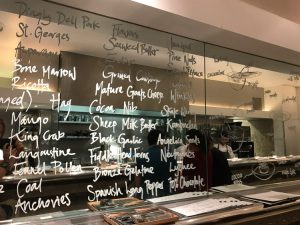
Venue and setup
It’s small, simple and holds about 20 covers. This isn’t a proper restaurant dressed up as a marketing stunt to bring in punters, it’s a lab with an oven. The whole thing is very casual. The room is thin, just enough room for a long thin marble bartop and space either side for staff to engage and serve. At one end is a waiter, explaining the concept, the menu and the dishes.
At the other is Simmonds, in his chef whites, tattooed and brooding, fiercely staring into his laptop. The cooking is very much on display. In between Simmonds and our waiter are four chefs, working on various dishes, small but clearly intricate. It’s complex and looks as though it should be stressful but there is an air of calm that suggests things are going rather well.
Everyone seems to be in total control, and every now and then Simmonds is on his feet, adding some experience; a special touch; a final flourish. He’s heavily involved without micro managing so you still feel like you’re getting the special treatment.

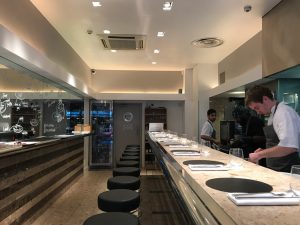
The menu is split into four sections – veg, fish, meat, and dessert, each with four options. The dishes all combine multiple components that have equal opportunity to surprise, delight and offend. Salt baked swede with blackberries and cocoa nibs; poached scallop with Nashi pear and sesame; lamb with salsify and milk skin; goat’s milk tofu with watermelon. It’s clear from the menu that testing these dishes makes a whole lot of sense.
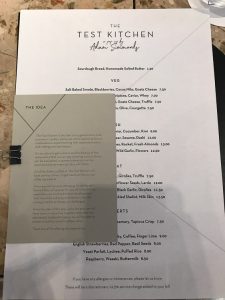
Veg
We begin this journey with white asparagus accompanied by Linzer potatoes, caviar and whey; and a portion of goat’s milk tofu with watermelon, goat’s cheese and truffles.
White asparagus is tender but retains a reasonable crunch. The Linzer potatoes, looking small and sweet, come in two forms – boiled with skin on, and fried as crisps to add texture. The caviar forms part of the foam sauce coating the dish and is present but not discernible amidst the strong heavy flavour of the whey. It’s all a little overpowering to the subtle taste of the asparagus and a slightly confused dish but it’s still an interesting start.
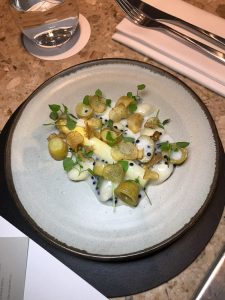
Goat’s milk tofu is an explosion of flavours – each adding a new layer of taste and fun as the dish moves from tastebud to gullet. The tofu is silky, replicating the texture of the traditional soya ingredient but with a salty flavour exacerbated by the goat’s cheese in the dish. It’s about to become too strong a flavour until the sweetness of the watermelon creeps in and blows the whole dish into balance.
It’s impressive to be able to bring these flavours together in a way which delivers such equilibrium – a trait that flows through the rest of the dishes we test and which characterises this entire endeavour.

Fish
For the fish course we select two very different options – rock oyster with Oscietra caviar, cucumber and kiwi; and cured red mullet accompanied by green tomatoes, rocket and fresh almonds.
Both are served by Simmonds himself who has decided to take up the baton of ‘dish explainer’ and runs through the details with a vigour that displays the true passion he has for the creations that have emerged from his slightly crazy mind. “Why oyster and kiwi together?” I ask. “Because when you blend a kiwi flesh with the seeds it tastes like oysters.” Explains Simmonds. Who knew? He did….and that’s essence of his genius.
It’s becoming clear that Simmonds is a flavour savant. He’s not necessarily in control of the ideas, but he lets them run. The results are pretty incredible.
The rock oyster dish is, hands down, one of the best examples of fine cuisine these reviewers have ever tasted. Layer upon layer upon layer of flavours – the seaside salt of the oyster; the lingering decadence of the oyster cream; the sharp saline tang of the Oscietra caviar (clearly a level above the caviar used as part of the whey foam in the earlier asparagus dish); the bitterness of the kiwi; all wrapped in the palate cleansing freshness of the cucumber.
It explodes as you eat it, encouraging to work harder and dig deeper into your memory bank of flavours and tastes to pull apart this culinary jigsaw puzzle of a dish. This is where the mindfulness comes into play – you have to really drill into the moment, into the experience, and into the sensations created in your mouth to fully appreciate what’s happening here. It’s a small serving but I’m thinking about it for days afterwards. Spectacular stuff.

The red mullet is also rather special (though it can’t hit the level of the rock oyster). Delicate fish, smothered in a puree of rocket and tomato that should be both bitter and sharp but is somehow neither, instead offering a creamy and savoury blanket that balances out the smoke of the mullet. Delicately placed edible flowers and the whitest almond halves I’ve ever seen – add flair and texture to an already impressive ensemble.
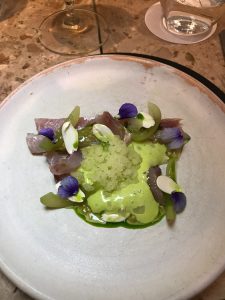
Meat
We can’t choose between the four meats so we sample them all. Any other human would do the same when faced with a similar conundrum. First up is pheasant egg with girolles and truffle for my colleague while I take veal sweetbreads with broccoli and black garlic.
The pheasant egg is clearly a winner as it’s devoured next to me with almost military-grade voraciousness. I can’t tell you much about it from personal experience but he claims it was both dense and light simultaneously and that the egg provides the dish with a way to create its own sauce during the scoffing.

Veal sweetbreads are firm and buttery, toasted in the pan with black garlic to savoury perfection but without attaining any of the grease or oil that most mortals would clearly suffer during the making of this sublime dish. Broccoli shouldn’t really go with this strong flavour. It’s a bit ‘school dinners’.
But here, lovingly crafted into a subtle cream it plays an essential role, dousing the salt of the sweetbreads, smothering it to just the right level at the end of eating to bring the whole thing into total stability.
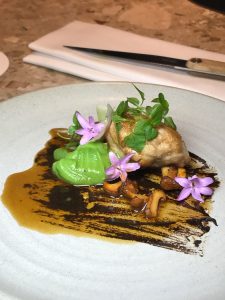
Then comes the lamb. The quality is now getting ridiculous. Two cuts presented with milk skin (that’s right – the stuff you get when you leave the custard out overnight). When asked how he came up with the idea of pairing milk skin with lamb we get a peek inside the mind of one of the fastest rising stars in British fine dining. “I just thought of lamb and my brain told me it just goes with milk skin” explains Simmonds.
There it is folks – it’s just that simple. You just think of stuff, and it goes together. Try it – I guarantee it won’t taste like this. Let’s start with the lamb – cooked two ways, pan fried medium rare and slow cooked to perfection. Both deliver completely different flavours and textures.
The result is that each connects with the milk skin, the salsify (apparently making a major comeback) and the pickled shallots in completely different ways, which effectively gives you two dishes in one and a matrix of choices of what to eat with what, when, and in which order. It’s magic. I’d have it every day if I had the option (and the funds).
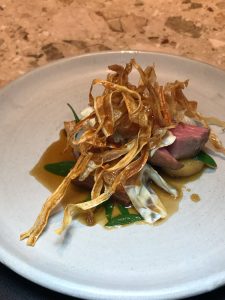
Quail ends the carnivore’s smorgasbord, served with asparagus, sunflower seeds and lardo. It’s a great combination of light, soft, and gamey meat with a crunch from the asparagus, chopped into uniform cylinders of bright green, as a base. The lardo – a rarity – is a single slice, sitting proud across the entire ensemble, wafer thin and mesmerizingly translucent. It adds little flavour but the texture is welcome and works.
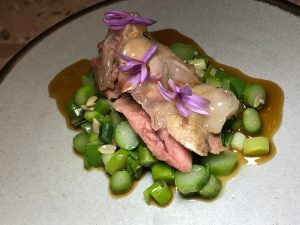
Dessert
I’ve done a few reviews recently where the dessert options let down a very strong starter, main and sides. It remains overlooked by all but the best of the best. But we’ve come this far so hopes are high. We’ve asked Simmonds which desserts he recommends. He lists all four on the menu so that approach goes out of the window. He does however refer to one as ‘a certainty for the final restaurant’s menu’ – a yeast parfait with puffed rice and lychee.
He struggles to explain it himself so we order it immediately. Before it arrives however, we try the chocolate mousse with whiskey, coffee and finger lime; and the raspberry with wasabi and buttermilk.
The raspberry doesn’t quite cut it. It’s presented as a tart sorbet, alongside a log of green pafait with a sweet milky flavour and a hint of wasabi coming in at the end. No heat – just a passing essence as you consider the sensations on your tongue. The buttermilk accompanies as a panncotta.
It lacks any real flavour and feels a little out of place. Amongst a showing across three courses demonstrating the extraction of maximum flavour with total discipline for balance, this dish loses its way and feels like it needs work. It’s no disaster but in this company, it stands out more than it would in a solo showing.
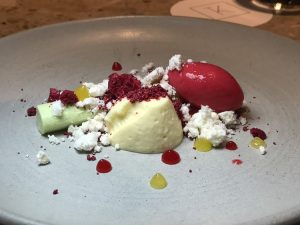
It’s more than compensated for by the mousse which we both agree is one of the all time great desserts. It’s not just the flavours it’s their combination with the textures that makes the whole thing come alive and dance across your mouth. It’s rather difficult to describe but the look of hedonism that spreads across both our faces as we enjoy the slow release of sweet zests and aromas should say it all.
Unfortunately, we didn’t get a picture of ourselves as we were too busy indulging but take it from this reviewer – it’s a masterpiece. Mindfulness coming back into play, this is a small dish that requires real concentration to explore its true depth of its tastes and to fully understand its brilliance. If you ever have the pleasure of trying it – take a week off work and spend time with it. Every second offers a worthy reward.
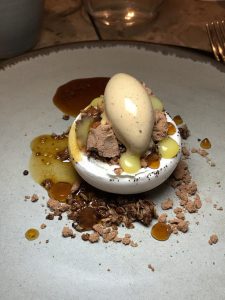
As a final flourish – the yeast parfait appears. What odd thing is this? A single boule of smooth creamy yellow oxide, with a lychee sorbet sidled up against it, sprinkled with what look like homemade sugar puffs. We give it a whirl. What. A. Finale. It’s certainly unusual. Is it salty? Is it sweet? Frankly we have no idea but I think it’s damn fine. My colleague not so much. It’s clear this is not a dessert – it’s a conversation piece.
A dish that could split a room and spark chatter all night. The only word we can both agree on to describe it is indescribable. All I can say is that anyone ordering this in the final restaurant next year will remember it for a long, long time. Special stuff.
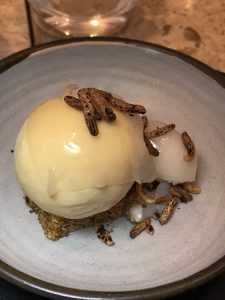
Value for money
The best way to handle this one is as follows: Each dish ranges from £7.50 to £13.50. The servings are small so in terms of £ per calories it’s not great. But I challenge you to find this quality of food and this depth of care and attention to the detail of flavours, anywhere in London, for this price. Yes you could spend £50 a head here quite easily but you’d come away with at least three new dishes in your top ten of all time.
Value is entirely relative but measured in pounds per pleasure centres triggered – its right up there.
Conclusions
You’ve probably worked out that I quite enjoyed this menu. Put simply it’s a dream for those who crave the experience of new flavour combinations. Simmonds and his team have put blood sweat and tears into extracting maximum flavour from every morsel and it shows. But what’s so special about this experience is that because you know these are experiments, you come at them in a very different way to those you pay for as finished articles in an established restaurant.
You question them, play with them, test them, and consider them rather than just eat them. You evaluate in a complete different way and you feel very free to challenge and recommend. It makes the ambience and atmosphere one of jovial engagement, friendly interaction, and it makes you feel valued as a perspective not just a punter. Not only does it engage you more but it makes you dig deeper into each dish to craft your opinion.
And that’s the clever bit. Because when you do so, you’re immediately playing into Simmonds’ hands. You’re instantly more aware and more mindful of what you’re experiencing, which by its very nature heightens the joy and the pleasure, and weds you tighter to the culinary experience in a way simply ‘eating in a restaurant’ can never achieve.
The theatre that other fine dining establishments need to inject to elevate themselves is simply not required, because bringing the customer into the whole process encourages them to create the theatre themselves. It lifts everything to a new level and for this reviewer, creates a new reference point for UK fine dining. If this is what Simmonds offers as a test run, one can only image how unreal the real deal with be. Go, experience, contribute, devour.

The Details
https://www.thetestkitchen.uk/menu
54 Frith Street, Soho
London, W1D 4SL
+44 (0) 207 734 8487
info@thetestkitchen.uk
